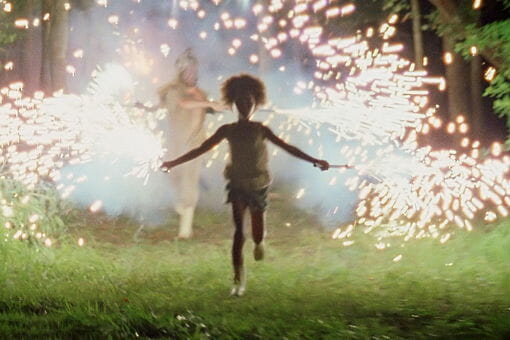By Ryan Mason · June 17, 2012

Beasts of the Southern Wild swept Sundance this year and after seeing it open before a packed audience at the Los Angeles Film Festival Friday night, it’s easy to understand why. The film it’s pure magic.
Shot on Super 16 with a cinéma vérité-style handheld camera, director Benh Zeitlin seamlessly blends fantastical elements within the documentary-esque footage to achieve a gorgeous hyper-reality set in the bayous of Southern Louisiana. Beasts tells the story of a father and daughter – Wink and Hushpuppy – who live in the small community known as the Bathtub, a society unto itself living on an island in the Gulf of Mexico just off the coast of New Orleans. Separated from the mainland by a massive levy, these outsiders refuse to leave when a devastating storm approaches. But ultimately, there are forces out there even greater than the howling winds and torrential downpours that threaten to push this family out of the only home they know.
Beasts is told from the perspective of Hushpuppy, a fearless six-year-old girl played by newcomer Quvenzhané Wallis – a total revelation up on the screen. Wallis is captivating as she runs around in her galoshes, completely impoverished – living in her own tree house (a trailer jammed up high in a tree to avoid the floods) across the way from her father’s – ever in tune with the animals around her and precociously independent. While Zeitlin’s choice to build real sets by hand and to use practical effects for the incredible look of the mythical aurochs – massive, prehistoric warthog-looking monsters – all convince us we were in this world just slightly outside our own reality, it’s only possible because of Wallis’ magnificent performance. She takes it up another notch by also providing the film’s narrative voiceover, which is pitch-perfect, at times sad, others funny, but always honest to what you’d expect from a highly aware six-year-old – and never pretentious.
Much of this falls on the amazing job of director Zeitlin and co-screenwriter Lucy Alibar’s honest script. Zeitlin spoke, after the screening, about how organic the filmmaking process was between the cast and crew. They cast the film with people who actually lived in the region (the fantastic Dwight Henry, who plays Wink, had to be persuaded numerous times to take the part because, as a small-business owner, he didn’t want to leave his bakery unattended for too long) and worked with them on the script during rehearsals to make sure that all the dialogue fit how they would truly say things. That process was a total success as what ended up on screen feels completely real, even when we know it’s not.
While the aurochs represent a blatantly physical depiction of the title, the film layers in many other options as to who might be these so-called beasts. On one level it’s clearly Wink and Hushpuppy, who regularly scream incoherently at the top of their lungs toward one another in primal – yet effective – forms of communication. On another it could be those from the modern world on the other side of the levy whose ideas of how one should live are in direct conflict with those of the families living in the Bathtub. Or perhaps it’s nature and the cyclical, permanent order of life and death. Or maybe our own demons and self-doubt that prevent us from being who we ought to be.
No matter what your interpretation, Beasts of the Southern Wild is a wholly satisfying experience that takes you both to a world you never knew and one that you only remember as a child.